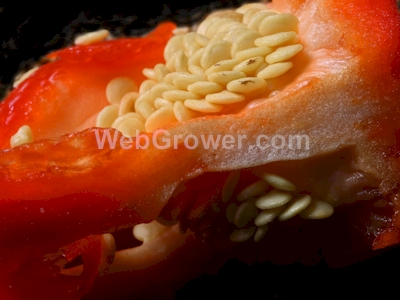Homepage → Seed Saving Information → Saving Pepper Seeds
Saving Pepper Seeds
Planted October 1, 2024
Last tended to on October 11, 2024
Reading time: 3 minutes

Production:
Pepper (Capsicum sp.) grows best in the dry season with temperatures that range from 70°F to 90°F. Overnight lows are especially important, as plants will tend to not set fruit at cooler temperatures. In order to reduce the possibility of issues with disease, observe crop rotation and do not plant in areas where the previous year’s crop was any Solanaceous species (tomato, pepper, eggplant, potato, tobacco, etc.). Removal and proper disposal of plant debris at the end of the gardening season is also beneficial.
Selection:
Referencing the documentation for the varieties that you planted, compare your plants and fruit to the written descriptions and photographs. If you observe any off-type plants, remove them as soon as possible in order to prevent contamination of your crop. This includes diseased or sickly plants, as well as ones that don’t match the variety’s documentation.
Isolation:
Pepper plants produce perfect, mostly self-pollinating flowers. This means that each flower contains both male and female structures and requires no insects to produce fruit. This does not mean that you should not take precautions. Solitary bees are attracted to, and will pollinate flowers, if other more desirable pollen sources are not available. Most home gardeners will do fine if they separate different varieties by about 50 feet, with another tall, wind breaking crop, like corn, in between. Caging plants with fine mesh is another option for maintaining purity. Commercial seed growers often isolate sweet pepper varieties by 1/4 mile, and as much as one mile between sweet and hot varieties.
Harvesting:
Harvest your peppers for eating or processing for food at whatever stage in their development as you prefer. However, for seed production, only select and harvest fully ripened, fully mature, unblemished fruit. For most pepper varieties, the fruit will have turned red in color.
Seed Extraction & Processing:
For home gardening purposes, saving seeds is a simple process. Remove the core from the pepper (see following image), or cut smaller fruited varieties open, and rub the seeds off of the pepper flesh and onto a coffee filter or paper plate that has been labeled with the variety.

Move your seeds to a location with good airflow, out of direct sunlight, allowing them to dry until they can be snapped in half. If they bend, give them more time. The top of the refrigerator in the kitchen is often a good place.
NOTE: This should be common sense, but when processing hot varieties, you should do so in a well ventilated area, preferably outdoors, and take care to not touch sensitive areas of your body. If you get an itch in your eye, DO NOT itch it! Personally, we recommend wearing disposable gloves when handling hot peppers.
Storage:
Once your seeds have adequately dried, they should be stored in a consistently cool, consistently dry, consistently dark location.
Refer to our article on seed storage for more information.
Copyright © 1998 - 2024 - All rights reserved
WebGrower.com℠ is a service mark of Victory Horticultural Group, LLC.
• Privacy Statement •
This site participates in the Amazon Services LLC Associates Program, an affiliate advertising program designed to provide a means for sites to earn advertising fees by advertising and linking to amazon.com.